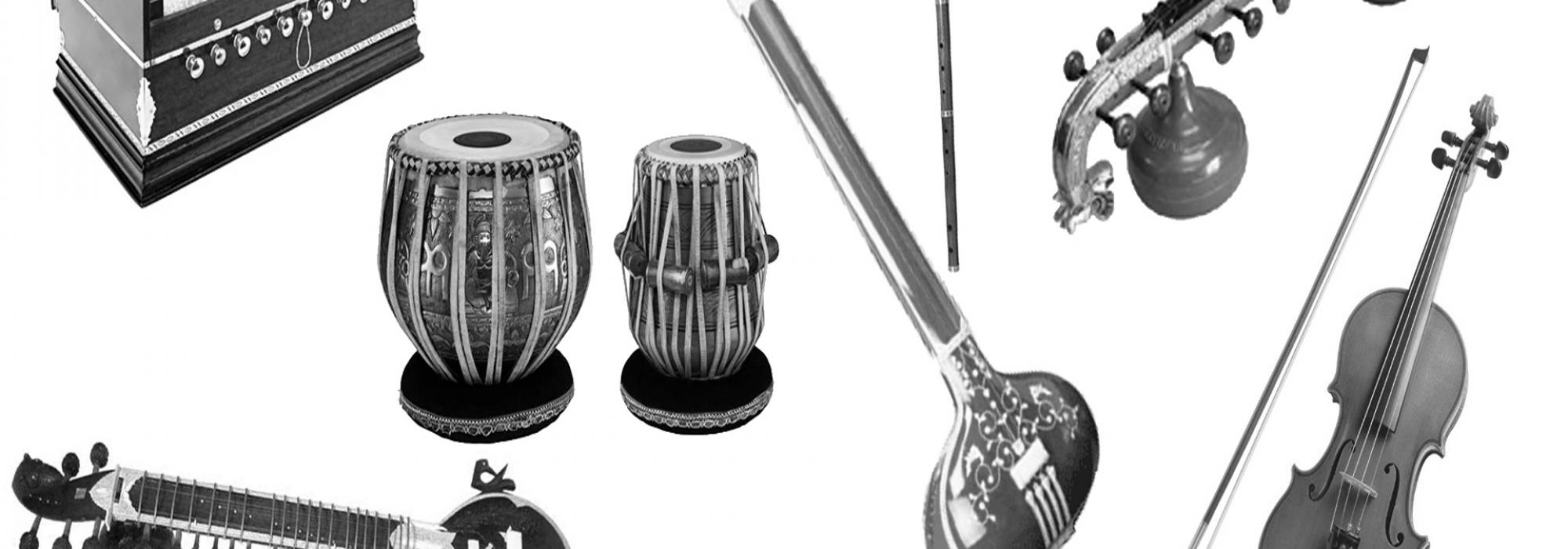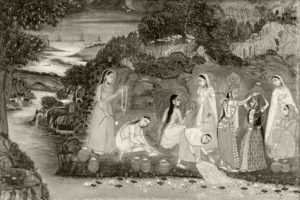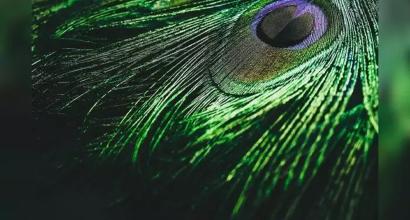Grahabedha is an interesting as well as a mesmerising facet of music. The science behind Grahabedha is very simple. The terminology becomes clear if it is called graha-svara-bedha instead [It may be noted that we discussed Graha in part-1. Graha means the ‘reference note’]. When Graha (i.e., the reference note, ‘Sa’) of a rāga is shifted sequentially to the notes that follow, i.e. if we start considering Ri, Ga, Ma.. of a rāga as reference notes, and sing rest of the notes relative to this new reference, the original rāga sounds a different rāga with each shift. The scientific term for this can be phase shift or tonal shift. This is a kind of auditory illusion. There has been no change to the original rāga chosen for elaboration. It is only the reference note which has been shifted and this gives the illusion of two different rāgas at the same time.
Achieving the effect of grahabedha on an instrument is relatively simpler; but to produce this effect in vocal rendition is highly challenging. The challenges arise because vocal rendition depends on synchronising with the Śruti(tonal reference, which is normally same as reference note) and then developing other svaras of the rāga relative to the śruti. Now, to shift the reference to next svara and being able to produce other scales and respective phrases is equivalent of entering the world of relativity. In an instrument, however, one can physically visualise the place of different notes. In a keyboard or a veena, there is a specific key or a fret for a particular note and in a flute, there is a specific combination of fingers that gives a particular note. Thus, the instrument itself aids in placing of svaras and shifting them. For a vocal artist, however, the shift is more abstract and the relative placement of the notes should be imagined. This demands a more precise adherence to śruti.
We have heard of differential spread, optical illusion, and several other visual effects, Graha bedha is their equivalent in music, so much like yamakālaṅkāra and citrakavitā in poetry. It requires great control of voice and voice culture to venture into Grahabedha. Many singers try Grahabedha only to find themselves like Abhimanyu that they cannot glide back to the original Graha easily after venturing in. There is also a risk of Grahabedha turning into a rāga-mālikā [sequence of different rāgas without tonal shift] if mismanaged. Moreover, if Grahabedha is over-used, it loses the special effect. The extent of usage of Grahabedha can be compared to the usage of pun (shleshalankara) in literature.
I consider the ability to render Grahabedha as good test of control over Śruti, which is fundamental to a singer. My guru Dr. Nagavalli Nagaraj is accomplished in rendering Grahabedha. Once during a recording of one of my compositions, I requested her to employ Grahabedha on the popular scale of Natabhairavi. Without second thoughts, my guru rendered Grahabedha, producing (Dheera) Shankarabharana, (Hanuma)Thodi, (Mechcha) Kalyani, Harikambhoji and Kharaharapriya in both ālāpanā and svaraprastāra. The beauty of that rendition still lingers in my memory.
To make the point that I like the four rāgas that emerge from Grahabedha of Hindola, I had to present this background of Grahabedha. Because of my personal taste for grahabedha and for the four rāgas that arise out of it, I have composed a kṛti starting in Hindola and a Thillana starting with Shuddha Dhanyasi with the assistance of my Guru.
Some masters like Dr. Balamuralikrishna have created magical renditions by employing Grahabedha on various rāgas. But as I already mentioned, the Natabhairavi-Shankarabharana-Kharaharapriya-Thodi-Kalyani-Harikambhoji and Hindola-ShuddhaSaveri-Shuddha Dhanyasi-Mohana-Madhyamavati are some of the most popular combinations of scales that can be traversed between each other using Grahabheda. Especially the Grahadebha set of Hindola is very attractive. The reason for this is the natural melody and enjoyable character.
Grahabedha cannot be exercised on all scales, for the new scales emanating out of Grahabedha become unidentifiable or undefined. For example - from the Grahabedha in a full scale like Natabhairavi, we get five rāgas and not six. But on the pentatonic scale of Hindola, we get four other rāgas. Therefore, the scale of any five consecutive notes gives a recognisable scale. The other factor for selecting Hindola for Grahabedha is this: Madhyamavati is the last rāga which we get in the cycle. In Carnatic music, there is a tradition of rendering Madhyamavati as the concluding rāga representing Mangalam or auspiciousness. Therefore the Grahabedha cycle also concludes auspiciously. It's perhaps due to this reason that all film songs having Grahabedha start with Hindola.
The first rāga emanating from the Hindola-Grahabedha cycle is Shuddha Saveri. In Hindustani style, this rāga is equivalent to Rāga Durga. It is a very enchanting rāga. Sa-Ri-Ma-Pa-Dha is the scale of Shuddha Saveri. Since I am trying to provide my personal experience and insight into these Rāgas, theoretical aspects can be done away with. I am neither eligible nor do I have any interest in dealing with it at a theoretical level.
Shuddha Saveri is a rāga that espouses the feeling of affection. Each svara is embellished and ornamented with gamakas [Shuddha Saveri is called Sarva-svara-gamaka-varika-rakti raga. Employment of gamakas by moving between adjacent notes instead of using plain notes is termed as ‘varika’] . Also because each svara is embellished, it opens up huge opportunity to explore and create musical and aesthetic possibilities. When sung without such ornamentation and if the voice is not well-cultured, Shuddha saveri doesn’t sound natural. This is applicable to other rāgas like Mohana, Atana, Brindavani, Kapi, Bilahari, Hamsadhwani and Mand too.
If ornamentation (gamakas) were to be the property of Suddha Saveri, it would have only evoked Veera rasa (Heroic pride). Love too, features as a predominant emotion in the delineation of the rāga. A rāga that suggests love (rakti) usually contains kampita, līna, ullasita, āhata, vali, ḍālu and other kind of gamakas. These bring out oscillation, association, gliding, wavering and stuttering respectively while moving between svaras.
A variety of features such as melody, brevity, swaying notes, peace and wonder come about in the rāga due to the presence of these gamakas. This is all the more evident in Hindustani treatment of Durga. Rishabha and Dhaivata are the jīva svaras, panchama is aṃśa svara. The rāga is best rendered in the medium tempo (madhyama-laya). Daatu-svara (“hopping notes”) and janti-svara (“conjual notes”) give a majesty to the rāga. The feeling of affection that is emoted in the transition rom Sa to Ri, turns to devotion moving to Ma. Panchama seems like the transition from introspection to indulgence. It provides the effect of a combination of Śiva -Rudra, Rāma-Kṛṣṇa. It represents the strength of Lalitā transforming into Durgā. Dha provides the victorious celebration over the enemy, and reaching the higher octave Sa, visualizes the Devī who blesses her devotees after saving them from evil, espousing a positive and peaceful feeling.
The ascending scale exemplifies the dawn with light as an innocent bride and the darkness a mature, awaiting lover. It gives a sense of transformation of dharma-vīra (in the beginning of the ārohaṇa) to yuddha-vīra (towards the end). It provides peace at the core and tenderness in the contours. In conclusion this rāga develops in the conjunction of strength and splendor.
[Translated from original Kannada by Vishwanath Chandrashekar; Edits and additional notes by Arjun Bharadwaj]












































